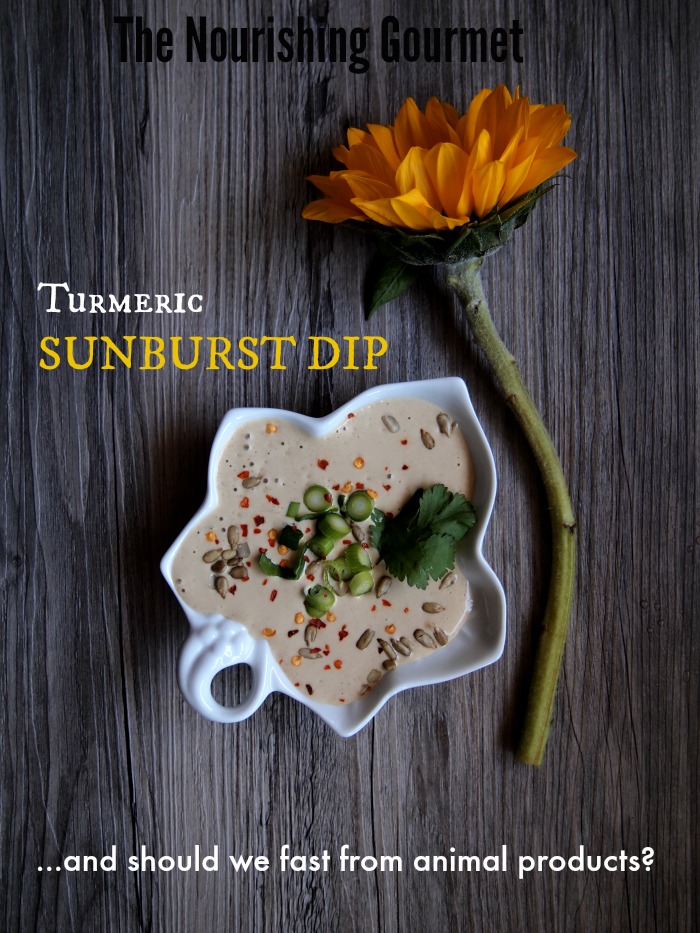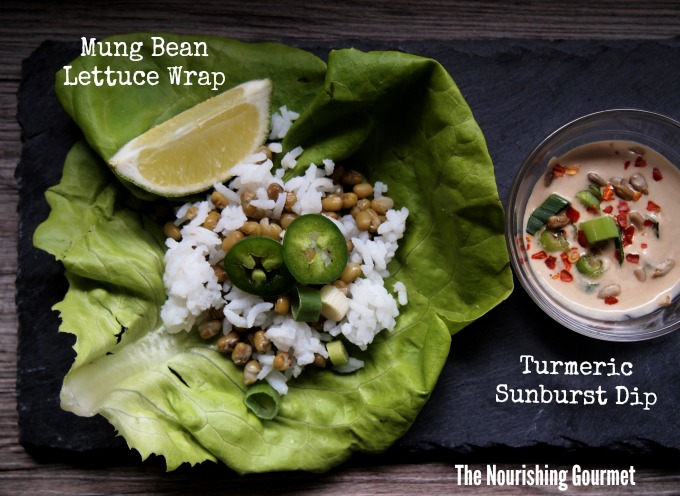This turmeric sunflower seed sauce is bursting with flavor and nutrition. It’s perfect as a dip for wraps and raw veggies, and is a great way to get protein when not eating animal meats. Natalia is fasting from meat products as she completes a traditional fast. One thing that I appreciated about Sally Fallon’s book, Nourishing Traditions, is that although she is an advocate of the benefits of traditional foods such as grassfed beef, eggs, and saturated fats in our regular diet, she also mentioned that there could be possible health benefits to cleanse diet/ fasts, for limited time periods (another traditional practice in many cultures). Natalia is exploring that concept for herself, as she talks through that issue in this post. -Kimi
By Natalia Gill, from An Appetite For Joy
You might guess that this dip was named for its sunflower seed base. Or for the burst of complex flavor that it brings – earthy turmeric, bright lemons and the kick of crushed red pepper. But truth be told, the inspiration for the name Turmeric Sunburst Dip is actually a little nerdy.
By now you’ve probably heard of turmeric’s unsurpassed power of reducing inflammation. Take a quick glimpse at this chart which shows the MANY causes of inflammation targeted by curcumin, turmeric’s active agent. How astounding and exciting! And it looks just like a sunburst! (Well, maybe technically a starburst. I improvised a bit.)
I’ve been dreaming up simple, healthy vegan recipes such as this one because I am currently fasting from most animal products. You might remember I was contemplating participating in the Orthodox Lenten Fast in this Buckwheat Crepes post. Well I took the plunge! Here are the guidelines.
ORTHODOX LENTEN FAST DIET PARAMETERS
- The fast lasts 40 days leading up to Easter, based on this calendar.
- No meat or animal products are allowed, with the exception of shellfish. Incidentally, shellfish happens to be an amazing source of B12 which isn’t found naturally in the vegan diet. Clams contain the most B12 of any food, surpassing even liver.
- Olive oil and wine (alcohol) are not allowed, except for certain days – usually Saturdays and Sundays.
- Fish is only allowed on two specified dates.
- If someone who is fasting is invited to eat in someone’s home who is not Orthodox, it’s ok to eat whatever is served.
- If fasting causes undue stress (physical, mental or spiritual) it can be deviated from at any time. Some describe it with the term “Economy” or “Oikonomia” meaning to use discretionary power or to handle things to the best of one’s ability.
Fasting provides a “time outside of time” – a physical shift that leads to a perception shift. I’ve noticed that things I’ve needed to work through on a spiritual level are coming to the surface.
I’ve also been reflecting on the potential health benefits and I’d like to share my thoughts with you and raise some questions. I’d love to hear your thoughts as well.
3 REASONS THE ORTHODOX FAST MAY BENEFIT HEALTH
1. Tradition
The practice of giving up meat intermittently is an ancient practice, across all cultures, religions and philosophical practices. This particular fast has been around since the 4th century. I’m most familiar with it’s place in a traditional Russian diet. Russians eat a balanced diet that includes meat, healthy animal fats and cultured dairy. But it has always been interwoven with the complete elimination of animal products.
Since we seek wisdom by looking back at “nourishing traditions” it seems that this type of fasting should be considered as part of the whole picture.
2. Detoxification
I believe grass fed beef, pastured eggs, chicken stock, etc. are healing and deeply nourishing and I include them regularly in my diet. But in the back of my mind is the nagging reality that the farther up the food chain we go, the more concentrated environmental toxins can become, some of which may unavoidable even if we source our food carefully (source).
Is there value in giving the body a rest and flushing out some of these toxins that could be accumulating in the body?
3. Variety & Rotation
It seems that our bodies were designed for a rotation diet. Eating seasonally and seeking variety are ways to rotate the foods we eat.
I’m guessing that hunter-gatherers took breaks from meat when it wasn’t available. Later, fasting became more intentional. Maybe this sort of fasting is a missing element in a “modern traditional” diet?
CHALLENGES TO FASTING FROM MEAT
Without a doubt there are circumstances that would make a meatless fast challenging, stressful or even impossible. Diabetes, autoimmune disease, grain & legume intolerance to name a few.
I was concerned about doing a disservice to my digestive system as some of my healthy gut habits would be dropped. So I decided I would deviate from the fast as needed – an egg here and there, olive oil on days that it’s “not allowed”, anchovies on cheeseless pizza on a non-fish day … “oikonomia”.
And after some transition, I feel great. I sense that my digestion will be better able to receive and absorb all foods, when they are reintroduced in a couple of weeks.
So back to this delicious dip! A true representation of the joy that lies within a fast.
I love it alongside lettuce wraps filled with rice, mung beans, cilantro, jalapeno and green onions. Drizzled with a squeeze of lime, this was such a flavorful and satisfying lunch! You’ll find both recipes below.
OTHER NOURISHING FAST-FRIENDLY RECIPES
- Late-Summer Garden Veggie Soup
- Pasta e Fagioli
- Thai Inspired Pizza with Peanut Sauce (omit chicken)
- Healthy Gluten Free Pizza
- Fennel Apple Gratin
- Spiced Honey Caramel Custard with Apples
- Chai Coconut Milk Ice Cream
What do you think? Is the traditional practice of fasting animal products an important piece of the puzzle?

- ⅓ cup water
- ⅓ cup sunflower seed butter (preferably made from roasted seeds without added sweeteners)
- 1 teaspoon turmeric, freshly grated (can sub ginger)
- 2 tablespoons honey
- 1 tablespoon tamari (I use reduced sodium)
- 1 tablespoon fresh lemon juice
- 1 tablespoon rice wine vinegar
- 1 garlic clove, chopped
- ¼-1/2 teaspoon crushed red pepper
- Blend ingredients together. Taste & add water if a thinner consistency or lighter taste is desired. Garnish with cilantro, green onion, crushed red pepper and sunflower seeds.
